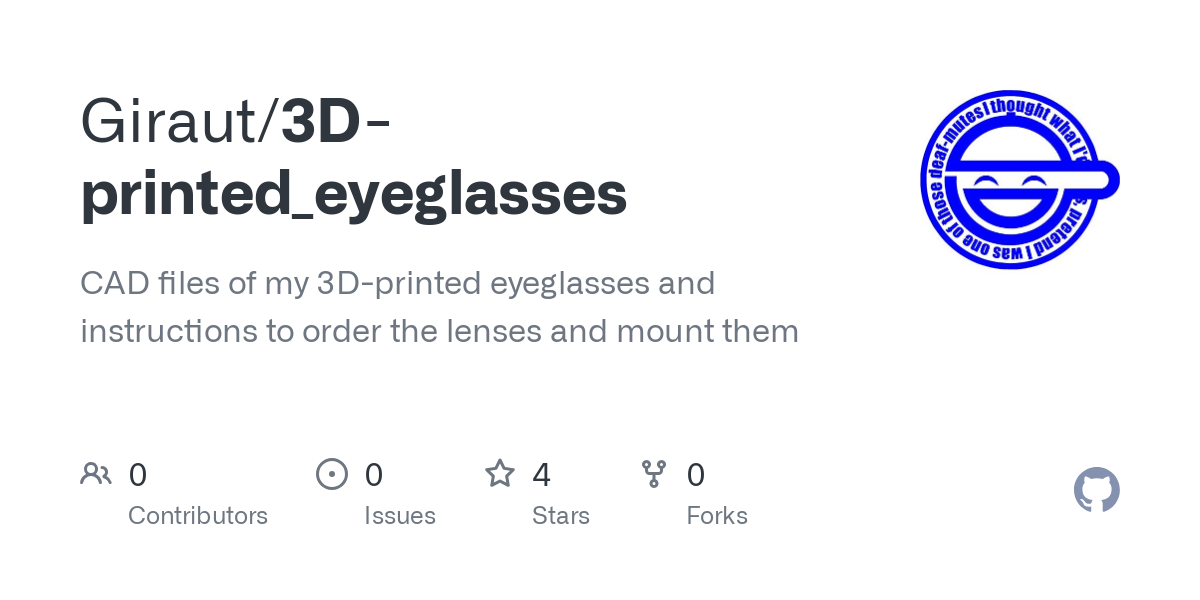You might recall last month that I posted about my 3D-printed spectacles.
Enough people asked me for the files and for details on how to order lenses and mount them into the frames that I figured I’d release everything with instructions - and also redesign the hinges a bit so the temples fold more compact, something I meant to do for some time.



That’s unfortunate. I’m trying to troubleshoot some problem that may be due to how the lens are made (or not). So having some understanding and control of that part of the process could have helped.
Good question. I weighed my current frame + lens and printed frame + trial lens to pick trial lenses that match the weight. Like you, I’m execting to be lighter in the end but wanted to be on the safe side when tweaking the frames.
The trial lens are indeed glass but I’m using “plano” (0D) lenses because those match the weight. The actual lens is/will be plastic, but not polycarbonate. Its some material that’s only referred to by its index of refraction.
I’ll definitely add cable temples to the list of things to try and see what works well.
Nice! I haven’t even thought about the case yet. I was probably going to reuse an existing case but now this is giving me ideas :) Although at this point, I’m still mainly focused on solving the (medical) problem or at least gain some insight.
Indeed. Unfortunately, the main thing I want to do with 3d printing is to make frames with smaller lenses. They don’t make these other than for children and child-sized faces. So I don’t have any old glasses with lenses of that size.
The only things you can rely on with regard to how the lenses are edged is:
The bevel will be “bevelly” - meaning it’ll be a bevel of some kind, between 90 and 120 degrees, but no flatter than that. In other words, you can rely on having something to grip the lens with and that’s enough.
The bevel follows the curvature of the frame. If you frame is flat, the bevel will be placed all around the edge of the lens flat too.
As much as your correction will allow, the bevel will be placed as far forward as possible so the lens looks like it’s tangent with the front of the frame all around, and all the thickness will be hidden at the back of the frame. So if your frame is, say, 2mm in width, the root of the bevel will be placed 1mm from the front of the edge.
The other thing you can rely on is that the bevel will be slightly oversized so they can be snapped into the frame, and the amount of oversize will be a bit higher for plastic frames which are more flexible. And that’s where the danger lies: if your frames are designed to hold the frame without pressure like mine, you have to tell the optician so they pass the information to the lens cutter. Otherwise you will received lenses that are slightly too big.
But don’t sweat it too much: the great thing with 3D printing is, even if the lenses you received aren’t the right size, you can always print another frame with slightly revised dimensions.
And if you really don’t want to print another frame, don’t forget that you pay beaucoup bucks for those damn bits of plastic, so you can always copiously warn the optician that your frames are not made of the kinds of plastics plastic frames are usually made of, and then the onus will be on the lens maker to make the lenses right for your frames (remember that they will be sent your frames, so they’ll know rightaway if the lenses fit).
If the lenses aren’t right, it’s their problem and you can reject the lenses and tell them to try again. If you warn the optician in no uncertain terms that your frames are PLA, they or the lens maker can’t claim they didn’t know.
Just design the frames you want with the shape you want, with a 120-degree bevel, and ask your optician if it’s workable for the lens maker. They might tell you they’ll ask them - and you can leave them a test print too if they want to sent it to the lens maker too. There isn’t much more to this really.
Be aware that cable temples are a lot more finicky to adjust than regular curved temples. If they’re too short, even a little, they’ll dig into the skin behind your ears and you’ll hate them. Likewise, if the hook is too narrow, the tip will hurt you under your ear.
That’s a big reason why cable temples went out of favor in the 1920’s: they’re great when they’re well adjusted, but they quickly become nasty and uncomfortable when they aren’t - unlike maladjusted curved temples which can simply ride up the ear a little without too much drama.
With regular metal wire, you can bend the temples this and that way to make them fit. Not so much with PLA. You can shape it with heat but if you do it more than once, it becomes rough and unpleasant to wear - if the PLA doesn’t delaminate completely. So take the time to design the right length and shape directly in your model. It’s a bit long and tedious but once you know the right dimensions, you’ll love how natural they feel.
Also, don’t make the wire too thin or it will dig into your skin as well. And too thick will make the wire inflexible and difficult to put on. The wire profile that works best for me is this (for PLA):